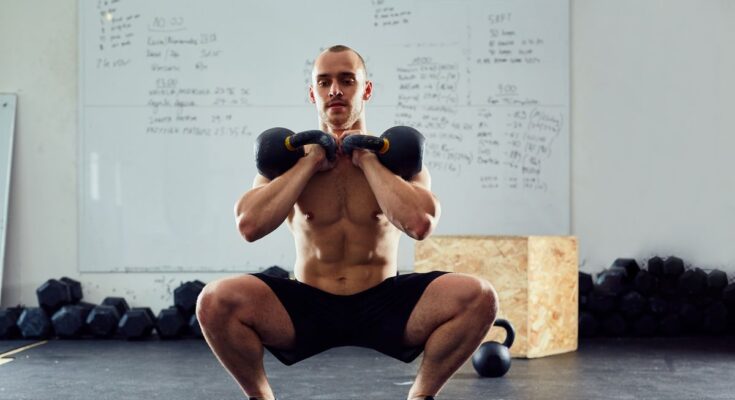Squats are a cornerstone exercise in strength training, beloved for their ability to build power, endurance, and resilience in the lower body. However, reaching a plateau can be frustrating, signaling that it’s time to diversify your training regimen.
Incorporating specific exercises can significantly enhance your squat performance, breaking through those plateaus and achieving new personal bests.
This article unveils five pivotal exercises designed to fortify your squat technique, elevate muscle strength, and ensure balanced development, propelling your fitness journey forward.
Why Squats are Fundamental to Your Workout Routine
Squats are often dubbed the king of all exercises, and for good reason. This powerhouse movement goes beyond mere leg training, offering a host of benefits that are crucial for everyone, from athletes to individuals seeking general fitness. Here, we delve into why incorporating squats into your workout routine can lead to transformative results, enhancing muscle building, core strength, flexibility, and improving daily functional movements.
Comprehensive Benefits of Squats
Muscle Building: Squats are a compound exercise that target multiple muscle groups simultaneously, including the quadriceps, hamstrings, glutes, and calves. This comprehensive engagement not only builds these muscles but also promotes the release of hormones that are vital for muscle growth throughout the body, making squats a must-do for anyone looking to develop a stronger, more toned physique.
Core Strengthening: While squats are primarily known for their impact on the lower body, they’re also incredibly effective at strengthening the core. Maintaining balance and posture during a squat requires significant engagement of the abdominal and lower back muscles. Over time, this leads to a stronger, more stable core, which is essential for both athletic performance and everyday activities.
Increased Flexibility: Squats also improve flexibility in the hips, ankles, and lower back, areas that are often neglected in typical daily movements. By promoting a greater range of motion, squats can help prevent injuries and enhance overall mobility, making it easier to perform a variety of physical activities.
Enhancing Daily Functional Movements
One of the most significant benefits of squats is their relevance to daily functional movements. Activities like sitting down and standing up, lifting heavy objects, or climbing stairs all mimic the squatting motion. Regularly performing squats strengthens the muscles involved in these movements, making them easier and more efficient. This not only helps in reducing the risk of injury during everyday tasks but also improves your ability to perform them effectively, contributing to a higher quality of life.
Incorporating squats into your routine is a simple yet impactful way to enhance overall fitness. Whether you’re looking to build muscle, strengthen your core, increase flexibility, or improve your ability to perform daily tasks, squats offer a comprehensive solution. Start with bodyweight squats to master the form and gradually increase the intensity to keep challenging your body. Remember, consistency is key to reaping the full benefits of this fundamental exercise.
By understanding the multifaceted benefits of squats, it’s clear why they are a cornerstone of any effective workout regimen. Their ability to build muscle, strengthen the core, increase flexibility, and improve daily functional movements makes squats an indispensable part of a balanced fitness plan.
Common Challenges in Performing Squats and How to Overcome Them
Squats are a fundamental exercise that target multiple muscle groups, including the quads, hamstrings, glutes, and core. However, many individuals encounter challenges that can hinder their performance and results. Understanding these common issues and addressing them can significantly enhance the effectiveness of your workouts.
Form Mistakes
One of the most prevalent issues in performing squats is incorrect form. Proper technique is crucial for maximizing the benefits of squats and minimizing the risk of injury. Common form mistakes include not going low enough, where the hips don’t drop below the knees, leading to incomplete muscle engagement. Another mistake is allowing the knees to cave inwards, which can strain the knee joints. Ensuring your feet are shoulder-width apart, keeping your back straight, and driving through your heels can help correct these issues.
Lack of Strength
A lack of lower body strength can make it challenging to perform squats correctly. This often results in not being able to squat deeply or maintain proper form throughout the exercise. Incorporating strength-building exercises, such as lunges and leg presses, into your routine can build the necessary muscle power to perform squats more effectively. Additionally, starting with bodyweight squats and gradually adding weight as you become stronger can help build foundational strength.
Mobility Issues
Mobility issues, particularly in the hips and ankles, can significantly impact your ability to squat properly. Limited flexibility can prevent you from achieving the full range of motion required for an effective squat. To improve mobility, incorporate stretching and mobility exercises into your daily routine. Focus on stretches that target the hips, ankles, and lower back. Foam rolling can also be beneficial for loosening tight muscles and improving flexibility.
Exercise 1: Lunges for Lower Body Strength
Incorporating lunges into your workout routine is an excellent way to enhance lower body strength, complementing the benefits you receive from squat exercises. Lunges primarily target the quadriceps but also engage the glutes, hamstrings, and core, providing a comprehensive lower body workout. Unlike squats, which emphasize the glutes and thighs, lunges offer a unique advantage by working each leg independently. This helps in correcting muscle imbalances and improving coordination.
How to Properly Perform Lunges: A Step-by-Step Guide
To reap the full benefits of lunges without risking injury, it’s crucial to perform them correctly. Here’s how to execute a standard lunge:
- Start Position: Stand tall with your feet hip-width apart. Keep your shoulders back, chest up, and gaze forward.
- Step Forward: Take a large step forward with one leg. Ensure your step is large enough to maintain balance.
- Lower Your Body: Lower your body until your front thigh is parallel to the ground and your back knee is close to touching it. Your front knee should be directly above your ankle, not pushed out too far.
- Rise Up: Push through the heel of your front foot to return to the starting position.
- Repeat: Perform the desired number of repetitions and then switch legs.
Lunges Variations and Their Benefits
Lunges come in various forms, each with specific benefits. Here are some popular variations:
- Static Lunges: Great for beginners, these are performed without stepping forward, helping you focus on form and balance.
- Walking Lunges: Add movement and cardiovascular effort by stepping forward into each lunge, alternating legs as you go. This variation enhances balance and agility.
- Reverse Lunges: Stepping backward instead of forward puts less strain on the knees, making it an excellent option for those with knee concerns.
- Side Lunges: These target the inner and outer thighs, improving lateral movement and flexibility.
- Lunge Jumps: An advanced variation that adds a plyometric component, increasing power and stamina.
Incorporating these variations into your training can help you achieve a well-rounded lower body workout, enhancing muscle strength, balance, and flexibility. Remember, consistency is key to seeing progress, so include lunges in your regular fitness regimen for optimal results.
Exercise 2: Glute Bridges for a Stronger Posterior Chain
The gluteal muscles, or glutes, play a pivotal role in the overall performance of squats. Acting as the powerhouse of the lower body, they contribute significantly to the squat’s effectiveness, influencing both the depth achieved during the squat and the stability maintained throughout the exercise. Incorporating glute bridges into your workout routine can significantly enhance the strength and functionality of your glutes, leading to improved squat performance. In this section, we’ll explore how to perform glute bridges correctly, and we’ll delve into the positive impact that strengthening your glutes can have on your squat depth and stability.
Importance of Glute Muscles in Squat Performance
The glutes are essential for generating the force needed to rise from the bottom of a squat. They are involved in hip extension, which is a key movement in lifting the body back to the standing position. Strong glute muscles ensure a powerful and efficient movement, reducing the risk of injury and enabling you to squat with heavier weights.
How to Perform Glute Bridges Correctly
- Start Position: Lie on your back on a flat surface, with your knees bent and feet flat on the ground. Place your feet hip-width apart, and ensure your spine is in a neutral position.
- Engage Your Core: Tighten your abdominal muscles to stabilize your spine and pelvis.
- Lift Your Hips: Pressing through your heels, lift your hips off the ground by squeezing your glutes. Raise your hips until your knees, hips, and shoulders form a straight line. Avoid overextending your lower back.
- Hold and Lower: Hold the top position for a count of two, ensuring your glutes remain engaged. Then, slowly lower your hips back to the starting position.
Impact on Squat Depth and Stability
Strengthening the glutes through exercises like glute bridges can have a profound impact on your squat depth and stability. With stronger glutes, you’ll find it easier to lower yourself into a deeper squat without compromising form. This increased depth enhances the squat’s effectiveness by engaging more muscle groups. Furthermore, strong glutes contribute to better stabilization of the hips and knees, minimizing wobbling and ensuring a safer, more effective squat.
Incorporating glute bridges into your training regimen is a strategic move towards achieving a stronger posterior chain. Not only does it boost your squat performance, but it also enhances your overall lower body strength and functionality, contributing to improved athletic performance and daily activities.
Exercise 3: Deadlifts for Core and Back Strengthening
Deadlifts are a cornerstone exercise for anyone looking to improve their squat performance. Not only do they target the lower body, but they also engage the core and back muscles significantly. Understanding the role of the core and back in squatting is essential for maximizing the effectiveness of your workouts and ensuring a comprehensive strength-building strategy.
The Role of the Core and Back in Squatting
The core and back muscles play a pivotal role in squatting by providing stability, power, and the correct alignment necessary for the movement. The core, encompassing the abdominals and the muscles surrounding the spine, acts as the central support system for the body. A strong core ensures you maintain balance and posture throughout the squat, reducing the risk of injury. Meanwhile, the back muscles, especially the erector spinae, support the spine, allowing for a proper and safe squat form. Strengthening these areas is crucial for enhancing squat performance and overall lower body strength.
How to Perform the Conventional Deadlift with Proper Form
Performing the conventional deadlift correctly is vital to reap the full benefits of the exercise while minimizing injury risk. Follow this step-by-step guide:
- Starting Position: Stand with your feet hip-width apart, toes pointing forward, and the barbell over your shoelaces. Bend at your hips and knees to lower your body, keeping your back flat.
- Grip: Extend your arms and grasp the barbell slightly wider than shoulder-width apart, using an overhand grip or a mixed grip (one hand overhand, one underhand) for stability.
- Lift: Engage your core and keep your back straight. Push through your heels to stand up, driving your hips forward and lifting the bar. Keep the bar close to your body as you rise.
- Top Position: At the top of the movement, your legs should be straight, shoulders back, and chest out. Avoid overextending your back.
- Lowering the Bar: Reverse the motion by hinging at the hips and bending the knees to lower the bar to the ground, maintaining a flat back throughout the descent.
Benefits of Incorporating Deadlifts into a Squat Improvement Plan
Incorporating deadlifts into your routine offers numerous benefits for improving squat performance:
- Increased Core and Back Strength: Deadlifts intensively work the core and back, enhancing stability and power, which are essential for a stronger squat.
- Improved Posture and Alignment: Strengthening the muscles around the spine promotes better posture and alignment, crucial for effective squatting and reducing injury risk.
- Greater Lower Body Power: Deadlifts target similar muscle groups as squats but from a different angle, contributing to overall lower body strength and power.
- Enhanced Balance and Coordination: The deadlift requires and develops balance and coordination, benefiting all aspects of squat performance.
By focusing on the core and back strength through deadlifts, you can significantly improve your squat technique, power, and safety. Remember, consistency and proper form are key to seeing progress and achieving your strength goals.
Exercise 4: Planks for Core Stability and Endurance
Building a strong core is essential for improving overall fitness, enhancing stability, and achieving better form in exercises such as squats. One of the most effective exercises for core strengthening is the plank. This exercise not only targets your abdominal muscles but also engages a wide range of muscles across your body, contributing significantly to core stability and endurance.
The Importance of a Strong Core for Better Squat Form
A robust core enhances your ability to perform squats with proper form. It acts as the central link between your upper and lower body, ensuring stability and balance throughout the movement. With a stronger core, you can maintain a neutral spine, prevent unnecessary forward lean, and distribute weight evenly across your feet. This results in a more effective, safer squat, reducing the risk of injury and maximizing the exercise’s benefits.
Variations of Planks and Their Relevance to Core Strengthening
- Standard Plank: The foundational plank position involves holding your body in a straight line from head to heels, with elbows under shoulders. It’s the starting point for building core endurance.
- Side Plank: By shifting your weight to one arm and stacking your feet, the side plank emphasizes the obliques and lateral core muscles, crucial for rotational movements.
- Plank with Leg Lift: Lifting one leg at a time while holding the plank position adds an extra challenge, engaging the glutes and lower back, and further stabilizing the core.
- Forearm Plank: This variation, performed on your forearms, focuses on endurance and strength in the abdominal muscles and shoulders, offering a different intensity level.
Each variation targets the core muscles slightly differently, promoting well-rounded strength and stability that benefit a wide range of movements, including squats.
Guide on Maintaining Proper Form During Planks for Maximum Benefit
To reap the full benefits of planks, maintaining proper form is key. Here are essential tips to ensure your planks are effective:
- Align your elbows directly under your shoulders to avoid strain on your shoulders and neck.
- Engage your core by pulling your belly button towards your spine, ensuring your body forms a straight line from head to heels.
- Breathe steadily throughout the exercise, as holding your breath can increase blood pressure unnecessarily.
- Avoid sagging hips to prevent lower back pain; similarly, lifting your hips too high reduces the effectiveness on your core.
- Keep your gaze down and neck neutral to avoid neck strain.
Incorporating these plank variations into your fitness routine can significantly enhance core strength and stability, contributing to better performance in exercises like squats and beyond. Remember, consistency and proper form are key to seeing progress.
Exercise 5: Box Jumps for Explosive Power and Mobility
Box jumps are a dynamic and powerful exercise designed to enhance your explosive power, a crucial element in improving squat performance. Explosive power refers to the ability to exert maximum force in the shortest possible time. This capability is not only essential for athletes but also for anyone looking to improve their physical fitness. By incorporating box jumps into your workout routine, you can significantly increase the strength and power of your lower body muscles, leading to improvements in your squat performance.
Steps for Safely Executing Box Jumps
To reap the benefits of box jumps while minimizing the risk of injury, it’s important to follow these steps:
- Choose the Right Box: Start with a box height that is comfortable for you to jump onto without straining. As your confidence and ability improve, you can gradually increase the height.
- Warm-Up: Always begin with a thorough warm-up to prepare your muscles and joints for the explosive movement.
- Stand Properly: Position yourself at a comfortable distance from the box, with your feet shoulder-width apart.
- Initiate the Jump: Bend your knees and hips to lower into a quarter squat position, then explosively jump up using the strength of your legs.
- Land Softly: Aim to land quietly on the box with both feet at the same time. Your knees should be slightly bent to absorb the impact.
- Step Down Carefully: Instead of jumping back down, step down one foot at a time to reduce the impact on your joints.
How Box Jumps Improve Mobility and Speed
Box jumps contribute significantly to enhancing mobility and speed. The explosive nature of the jump requires a full range of motion, thereby improving joint mobility and flexibility. This increased mobility allows for more efficient movement patterns, which can translate to faster speeds not only in exercises like squats but also in running and other activities. Furthermore, the rapid force production in box jumps trains your muscles and nervous system to act more swiftly, enhancing overall speed and performance in various sports and physical activities.
Incorporating box jumps into your exercise regimen can therefore provide a multifaceted approach to improving your physical capabilities, offering benefits in explosive power, mobility, and speed that contribute to better performance across a wide range of activities.
Incorporating These Exercises into Your Routine
Integrating new exercises into your workout routine doesn’t have to be a daunting task. With the right approach, you can seamlessly add them to your existing schedule, ensuring you reap all the benefits without feeling overwhelmed. Here are some tips on how to effectively include these exercises into your regimen, along with suggestions for workout frequency and progression for optimal results.
Start Small
Begin by incorporating a few new exercises into your routine, rather than overhauling your entire workout plan. This method allows your body to adjust to the new demands without risking injury or burnout. For instance, if you’re introducing strength training exercises, start with one or two sessions per week, focusing on major muscle groups.
Schedule Wisely
Consistency is key in any workout routine. Schedule your exercises at times when you’re most likely to follow through. Early morning, during lunch breaks, or in the evening after work are popular choices. Use a calendar or a fitness app to set reminders and track your progress.
Gradually Increase Frequency and Intensity
As your body adapts, gradually increase the frequency and intensity of your workouts. Aim for a balance between challenging yourself and listening to your body’s signals. A good rule of thumb is to increase the intensity or volume (number of exercises, sets, or repetitions) by no more than 10% per week.
Mix It Up
To prevent boredom and plateaus, vary your exercises, intensity, and workout formats. Incorporating a mix of cardiovascular activities, strength training, flexibility exercises, and balance training can keep your workouts interesting and cover all aspects of fitness.
Listen to Your Body
Pay attention to how your body responds to the new exercises. It’s normal to experience some muscle soreness when trying new activities, but sharp pain or discomfort is a sign to stop and reassess. Ensure you’re performing exercises with proper form to avoid injury.
Set Realistic Goals
Setting achievable goals can motivate you to stick with your new routine. Whether it’s improving your strength, increasing flexibility, or losing weight, having clear objectives can keep you focused and motivated.
Rest and Recover
Adequate rest is crucial for muscle recovery and performance improvement. Ensure you’re getting enough sleep and incorporating rest days into your workout schedule to allow your body to recover and grow stronger.
Incorporating new exercises into your routine can enhance your fitness journey, making it more enjoyable and effective. By starting small, scheduling wisely, and listening to your body, you can set the stage for success. Remember, consistency and progression are key to achieving optimal results. Keep challenging yourself, but also make sure to enjoy the process and celebrate your achievements along the way.
Monitoring Your Progress in Squat Strength and Form
Improving your squat strength and form is a journey that requires consistent effort and patience. One of the keys to success is regularly monitoring your progress. This allows you to identify improvements, understand areas that need more work, and stay motivated. Below, we offer guidance on how to effectively track your squat progression, ensuring your training remains both efficient and rewarding.
1. Keep a Workout Journal: One of the simplest yet most effective methods to track your progress is by maintaining a workout journal. Document every squat session, noting the weight lifted, the number of repetitions and sets, and any variations in the squat exercise you performed. Additionally, record how you felt during each workout, including any challenges you faced or breakthroughs you achieved. This not only helps in tracking your physical progress but also in understanding your mental resilience over time.
2. Use Fitness Apps: In today’s digital age, numerous apps are designed to help you monitor your workout progress. These apps often come with features that allow you to log your exercises, set goals, and visualize your improvements through graphs and statistics. Some apps also offer instructional videos to ensure your form is correct, enhancing both the effectiveness and safety of your workouts. Explore and select an app that best suits your needs and preferences.
3. Evaluate Your Form Regularly: While increasing the weight you can squat is a clear indicator of progress, improving your form is equally important. Periodically record videos of yourself performing squats from different angles. Review these videos to assess your form, or even better, share them with a coach or experienced lifter for feedback. Pay attention to your posture, the depth of your squat, and your overall technique. Improvements in these areas contribute significantly to your strength development and injury prevention.
4. Set Clear, Achievable Goals: Establish short-term and long-term goals for both your squat strength and form. Use your workout journal or fitness app to track your progress towards these goals. Celebrate the milestones you achieve along the way, and adjust your targets as needed to keep challenging yourself.
By actively monitoring your progress through these methods, you’ll gain a deeper insight into your development, helping you stay focused and motivated. Remember, the key to improvement lies in consistency, patience, and the willingness to learn and adapt. Keep pushing forward, and you’ll see remarkable improvements in your squat strength and form.
Conclusion:
In summary, squats are a cornerstone exercise in fitness, offering extensive benefits that range from building muscle to enhancing overall athletic performance. The effectiveness of the exercises we’ve discussed cannot be overstated when it comes to boosting your squat ability. Incorporating them into your routine will not only improve your squat form and strength but also contribute to a more balanced and resilient physique.
Achieving noticeable improvements in your squat performance requires both consistency and patience. Like any skill, mastery comes with time and dedicated practice. Therefore, it’s crucial to remain committed to your training regimen, ensuring that you regularly perform these supportive exercises. Remember, the journey to enhancing your squat capability is a marathon, not a sprint. Incremental progress, no matter how small, is still progress.
We encourage you to approach your squat training with a positive mindset, embracing each session as an opportunity to grow stronger and more proficient. With dedication and perseverance, you’ll soon notice significant enhancements in your squat performance, leading to better fitness levels and achieving your personal health goals. Stay patient, stay consistent, and let the power of squats transform your physical well-being.



